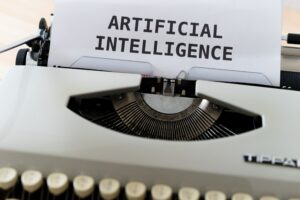Despite the many dystopian predictions that AI will replace humans, organizations are finding that AI is best applied as a complement to the traditional workforce. As well articulated in the study, ‘Cognitive Diversity – AI and the Future of Work’, competitive advantage is derived not from the technology itself, but rather from using it to complement and magnify the experience, expertise, and creativity of employees. In this blog, Tata Communications’ Peter Quinlan, VP of Business Collaboration, explores how AI can be integrated into processes and a network of human talent.
Finding the Right Fit for AI
Companies today have an unprecedented amount of valuable customer and employee data – information that can be made available to any device, anywhere. They face a challenge, however, in extracting and interpreting all this data in  real-time to drive business benefit – be it to better serve their customers, improve products, or drive efficiencies.
real-time to drive business benefit – be it to better serve their customers, improve products, or drive efficiencies.
Any company that can find a better way to leverage their data can steal a march on their competition, and in some cases their survival may depend on it.
“Many see AI as a solution to harness and monetise all this information, but advances in automation and machine learning will only help humans to better leverage data to make more timely decisions, better aligned with the needs of their business.”
Intelligence Augmentation
This approach to AI, wherein machines enable people to work in more efficient, meaningful ways, is known as Intelligence Augmentation, or IA. It’s an idea that highlights AI’s potential to help individuals become more agile and effective in their roles. And there’s a lot to be gained by adopting it as a company-wide strategy.
A Gartner report identified that the greatest business value AI will provide in the coming years is decision making support, not process automation. Organizations will see the most benefit from AI implementation strategies that aim to better engage, rather than replace human employees. The report further projected that IA will drive net job growth, generating an estimated $2.9 trillion in business value and recovering 6.2 billion hours of worker productivity in 2021.
 Some key industries are already seeing the benefit of Human-AI collaboration. Global contact centers are using Natural Language Processing (NLP), to listen to and identify patterns in interactions. NLP and sentiment analysis can be used to monitor emotional levels on a call in real time, and to identify known red flags, so the agent can be given advice on how to handle the situation in the moment, or allowing the call to be routed to a supervisor who can intervene before a negative outcome is realised.
Some key industries are already seeing the benefit of Human-AI collaboration. Global contact centers are using Natural Language Processing (NLP), to listen to and identify patterns in interactions. NLP and sentiment analysis can be used to monitor emotional levels on a call in real time, and to identify known red flags, so the agent can be given advice on how to handle the situation in the moment, or allowing the call to be routed to a supervisor who can intervene before a negative outcome is realised.
Insights generated by applying NLP to large volumes of calls, analyzed with machine learning, can be used to generate successful scripts, training materials, and real-time assistance for agents. In this way, AI is able to make the organisation’s collective depth of insight and emotional intelligence, gleaned from huge volumes of experience from their best – and worst – agents, available to every agent on every customer interaction. Making AI-generated best practice generally available can raise the performance of the entire team, or even help bridge cultural divides for employees in offshore locations.
“In the customer services space, AI can help to make interactions more human. The identity verification process, loathed by customers for its seemingly endless manual security prompts, can be simplified and streamlined by speech recognition which allows the system to recognise the customer in a more natural way.”
AI can also structure interactions to maximize the customer’s convenience, as agents equipped with tailored information on an individual’s needs can reach out proactively in ways that fit the customers’ schedule and preferences. Based on history, the customer’s pre-defined preferences, or the specific situation, interactions can be scheduled or on-demand, self-service or fully supported, and through text, voice, or video, on any device, or a combination of these. Interactions enabled in this way improve not only customer satisfaction and brand image, but also employee experience and overall business productivity.
Connecting the Workplace
AI can be applied in similar ways to day-to-day business communications in global organisations with connected, mobile workforces. Collaboration technology has already brought diverse, global teams closer together, creating new opportunities – and also new challenges – to effective communication.
“Usage of these technologies and the need for improving their effectiveness have only increased with work-from-home measures in response to the global pandemic.”
NLP and AI can already improve efficiency by transcribing meetings, making recordings indexable and searchable, and generating meeting minutes and action lists.
But given the global nature of business, conferences calls often require advance knowledge of diverse customs, sensitivities and, potentially an understanding of foreign languages. AI can also be used to generate profiles of meeting  participants and to refine talking points based on publicly available information. In the meeting itself, NLP could be used to process multiple languages and translate in real time, adding suggested nuances or context to points made. As in the call center example, AI could use sentiment analysis to identify emotions or cultural sensitivities and suggest alternative responses in real time. We’re only beginning to scratch the surface on potential applications, but the common denominator is clear: AI represents a tremendous opportunity to facilitate and enhance, not replace, person-to-person collaboration.
participants and to refine talking points based on publicly available information. In the meeting itself, NLP could be used to process multiple languages and translate in real time, adding suggested nuances or context to points made. As in the call center example, AI could use sentiment analysis to identify emotions or cultural sensitivities and suggest alternative responses in real time. We’re only beginning to scratch the surface on potential applications, but the common denominator is clear: AI represents a tremendous opportunity to facilitate and enhance, not replace, person-to-person collaboration.
The above examples are admittedly generic and could be applied to any industry. We have not even begun to talk about the application of AI in specific contexts of vertical industries or leveraging AI and myriad data generated by IoT to enhance and extend human capabilities. That may be a topic for another day, but in the meantime, one thing is clear: AI represents a tremendous opportunity to magnify the impact of the organisation’s collective human capabilities and knowledge to differentiate, hone competitive advantage, and transform customer and employee experience.
Discover more about how tech such as AI is making the world a better place.
Transformational Hybrid SolutionsOur cloud-enablement services offer the best performance on your traffic-heavy websites or mission-critical applications.
Core NetworksTata Communications™ global IT infrastructure and fibre network delivers the resources you need, when and where you need them.
Network Resources
Unified Communications As A ServiceBreak the barriers of borders efficiently and increase productivity with Tata Communications’ UC&C solutions.
Global SIP ConnectEmpower your business with our SIP network and witness it grow exponentially.
InstaCC™ - Contact Centre As A ServiceCloud contact centre solutions for digital customers experience and agent productivity.
Unified Communication Resources Case studies, industry papers and other interesting content to help you explore our unified communications solution better.
IoT SolutionsThe Internet of Things is transforming the way we experience the world around us for good. Find out more about our Internet Of Things related solutions here.
Mobility SolutionsTata Communications’ mobility services enable your enterprise to maintain seamless communication across borders, with complete visibility of cost and usage.
Mobility & IoT Resources
Multi-Cloud SolutionsWith enterprises transitioning to a hybrid multi-cloud infrastructure, getting the right deployment model that yields ROI can be a daunting task.
Cloud ComplianceCompliant with data privacy standards across different countries and is also designed to protect customers’ privacy at all levels.
IZO™ Cloud Platform & ServicesIZO™ is a flexible, one-stop cloud enablement platform designed to help you navigate complexity for more agile business performance.
Managed Infrastructure ServicesIntegrated with our integrated Tier-1 network to help your business grow efficiently across borders.
Cloud PartnersWe support a global ecosystem for seamless, secure connectivity to multiple solutions through a single provider.
Cloud Resources
Governance, Risk, and ComplianceRisk and Threat management services to reduce security thefts across your business and improve overall efficiencies and costs.
Cloud SecurityBest-in-class security by our global secure web gateway helps provide visibility and control of users inside and outside the office.
Threat Management - SOCIndustry-leading threat-management service to minimise risk, with an efficient global solution against emerging security breaches and attacks.
Advanced Network SecurityManaged security services for a predictive and proactive range of solutions, driving visibility and context to prevent attacks.
Cyber Security ResourcesCase studies, industry papers and other interesting content to help you explore our securtiy solution better.
Hosted & Managed ServicesTata Communications provide new models for efficient wholesale carrier voice service management. With our managed hosting services make your voice business more efficient and better protected
Wholesale Voice Transport & Termination ServicesYour long-distance international voice traffic is in good hands. End-to-end, voice access & carrier services which includes voice transport and termination with a trusted, global partner.
Voice Access ServicesTata Communication’s provide solutions which take care of your carrier & voice services, from conferencing to call centre or business support applications.
Carrier Services Resources
CDN Acceleration ServicesOur CDN Web Site Acceleration (WSA) solution helps deliver static and dynamic content, guaranteeing higher performance for your website.
CDN SecuritySafeguard your website data and customers’ information by securing your website from hacks and other mala fide cyber activities.
Video CDNDeliver high-quality video content to your customers across platforms – website, app and OTT delivery.
CDN Resources
Elevate CXIncrease customer satisfaction while empowering your service team to deliver world-class customer experience and engagement.
Live Event ServicesTata Communications’ live event services help battle the share if eyeballs as on-demand video drives an explosion of diverse content available on tap for a global audience.
Media Cloud Infrastructure ServicesTata Communications’ media cloud infrastructure offers flexible storage & compute services to build custom media applications.
Global Media NetworkTata Communications’ global media network combines our expertise as a global tier-1 connectivity provider with our end-to-end media ecosystem.
Use CasesUse cases of Tata Communications’ Media Entertainment Services
Remote Production SolutionsMedia contribution, preparation and distribution are highly capital-intensive for producers of live TV and video content, and their workflows are complex.
Media Cloud Ecosystem SolutionsThe Tata Communications media cloud infrastructure services offer the basic building blocks for a cloud infrastructure-as-a-service.
Global Contribution & Distribution SolutionsTata Communications’ global contribution and distribution solution is built to reduce capital outlay and grow global footprint.
Satellite Alternative SolutionsAs more and more consumers choose to cut the cord & switch to internet-based entertainment options, broadcasters are faced with capital allocation decisions.
LeadershipA look into the pillars of Tata communications who carry the torch and are living embodiment of Tata’s values and ethos.
Culture & DiversityHere at Tata Communications we are committed to creating a culture of openness, curiosity and learning. We also believe in driving an extra mile to recognize new talent and cultivate skills.
OfficesA list of Tata Communications office locations worldwide.
FAQCheck out our FAQs section for more information.
SustainabilityOur holistic sustainability strategy is grounded in the pillars of People, Planet and Community with corporate governance at the heart of it.
BoardHave a look at our board of members.
ResultsFind out more about our quarterly results.
Investor PresentationsFollow our repository of investor presentations.
FilingsGet all information regarding filings of Tata communications in one place.
Investor EventsAll investor related event schedule and information at one place.
GovernanceAt Tata, we believe in following our corporate social responsibility which is why we have set up a team for corporate governance.
SharesGet a better understanding of our shares, dividends etc.
SupportGet all investor related contact information here.


